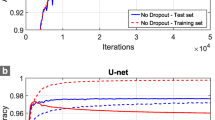Abstract
This paper considers the problem of corneal endothelium image segmentation using a method that combines a CNN model with a watershed transform. Specifically, first CNN predicts cell bodies, edges, and centers. Next, cell centers are used as markers that guide the watershed transform performed concerning the cell edge probability maps inferred by the CNN to outline cell edges. Different variants of the method are considered. Specifically, a downscaled U-Net is compared with the Attention U-Net in the image-to-image and sliding window setup. Results show that using a marker-driven watershed transform to post-process cell edge probability maps allows for replacing the sliding window setup with an image-to-image setup, reducing prediction time while maintaining similar or better segmentation accuracy. Also, when used as a backbone, Attention U-Net outperforms classical U-Net in determining cell morphometric parameters with high accuracy.
Access this chapter
Tax calculation will be finalised at checkout
Purchases are for personal use only
Similar content being viewed by others
References
Ronneberger, O., Fischer, P., Brox, T.: U-net: convolutional networks for biomedical image segmentation. In: Medical Image Computing and Computer-Assisted Intervention (MICCAI), vol. 9351 of LNCS, pp. 234–241. Springer (2015)
Fabijańska, A.: Segmentation of corneal endothelium images using a u-net-based convolutional neural network. Artif. Intell. Med. 88, 1–13 (2018). https://doi.org/10.1016/j.artmed.2018.04.004
Daniel, M., Atzrodt, L., Bucher, F., Wacker, K., Böhringer, S., Reinhard, T., Böhringer, D.: Automated segmentation of the corneal endothelium in a large set of “real-world’’ specular microscopy images using the u-net architecture. Sci. Rep. 9, 4752 (2019). https://doi.org/10.1038/s41598-019-41034-2
Vigueras-Guillén, J.P., Sari, B., Goes, S.F., Lemij, H.G., van Rooij, J., Vermeer, K.A., van Vliet, L.J.: Fully convolutional architecture versus sliding-window CNN for corneal endothelium cell segmentation. BMC Biomed. Eng. 1, 4 (2019). https://doi.org/10.1186/s42490-019-0003-2
Kucharski, A., Fabijańska, A.: CNN-watershed: a watershed transform with predicted markers for corneal endothelium image segmentation. Biomed. Signal Process. Control 68, 102805 (2021). https://doi.org/10.1016/j.bspc.2021.102805
Vigueras-Guillén, J.P., van Rooij, J., van Dooren, B.T.H., Lemij, H.G., Islamaj, E., van Vliet, L.J., Vermeer, K.A.: Denseunets with feedback non-local attention for the segmentation of specular microscopy images of the corneal endothelium with guttae (2022). https://doi.org/10.48550/ARXIV.2203.01882. arxiv:2203.01882
Zhang, Y., Higashita, R., Fu, H., Xu, Y., Zhang, Y., Liu, H., Zhang, J., Liu, J.: A multi-branch hybrid transformer network for corneal endothelial cell segmentation. In: de Bruijne, M, Cattin, P.C., Cotin, S., Padoy, N., Speidel, S., Zheng, Y., Essert, C. (eds.) Medical Image Computing and Computer Assisted Intervention—MICCAI 2021, pp. 99–108. Springer International Publishing, Cham (2021). https://doi.org/10.1007/978-3-030-87193-2_10
Selig, B., Vermeer, K.A., Rieger, B., Hillenaar, T., Hendriks, C.L.L.: Fully automatic evaluation of the corneal endothelium from in vivo confocal microscopy. BMC Med. Imaging 15(1), 13 (2015). https://doi.org/10.1186/s12880-015-0054-3
Oktay, O., Schlemper, J., Folgoc, L.L., Lee, M., Heinrich, M., Misawa, K., Mori, K., McDonagh, Hammerla, N.Y., Kainz, B., Glocker, B., Rueckert, D.: Attention u-net: learning where to look for the pancreas (2018). https://doi.org/10.48550/ARXIV.1804.03999. arxiv:1804.03999
Li, C., Tam, P.: An iterative algorithm for minimum cross entropy thresholding. Pattern Recogn. Lett. 19(8), 771–776 (1998). https://doi.org/10.1016/s0167-8655(98)00057-9
Dubuisson, M.-P., Jain, A.: A modified hausdorff distance for object matching. In: Proceedings of 12th International Conference on Pattern Recognition, vol. 1, pp. 566–568 (1994). https://doi.org/10.1109/ICPR.1994.576361
Freedman, D., Pisani, R., Purves, R.: Statistics (international student edition), Pisani, R. Purves, 4th edn. WW Norton & Company, New York
Sha, Y.: Keras-u-net-collection (2021). https://github.com/yingkaisha/keras-unet-collection. https://doi.org/10.5281/zenodo.5449801
Vigueras-Guillén, J.P., Sari, B., Goes, S.F., Lemij, H.G., van Rooij, J., Vermeer, K.A., van Vliet, L.J.: Fully convolutional architecture versus sliding-window CNN for corneal endothelium cell segmentation. BMC Biomed. Eng. 1(1) (2019). https://doi.org/10.1186/s42490-019-0003-2
Nurzynska, K.: Deep learning as a tool for automatic segmentation of corneal endothelium images. Symmetry 10(3). https://doi.org/10.3390/sym10030060. https://www.mdpi.com/2073-8994/10/3/60
Ruggeri, A., Scarpa, F., Luca, M.D., Meltendorf, C., Schroeter, J.: A system for the automatic estimation of morphometric parameters of corneal endothelium in Alizarine red-stained images. Br. J. Ophthalmol 94(5), 643–647 (2010). arXiv:https://bjo.bmj.com/content/94/5/643.full.pdf, https://doi.org/10.1136/bjo.2009.166561. https://bjo.bmj.com/content/94/5/643
Piórkowski, A.: Best-fit segmentation created using flood-based iterative thinning. In: Advances in Intelligent Systems and Computing, pp. 61–68. Springer International Publishing (2016). https://doi.org/10.1007/978-3-319-47274-4_7
Author information
Authors and Affiliations
Corresponding author
Editor information
Editors and Affiliations
Rights and permissions
Copyright information
© 2024 The Author(s), under exclusive license to Springer Nature Switzerland AG
About this paper
Cite this paper
Kucharski, A., Fabijańska, A. (2024). Modified CNN-Watershed for Corneal Endothelium Segmentation: Image-to-Image Versus Sliding-Window Comparison. In: Strumiłło, P., Klepaczko, A., Strzelecki, M., Bociąga, D. (eds) The Latest Developments and Challenges in Biomedical Engineering. PCBEE 2023. Lecture Notes in Networks and Systems, vol 746. Springer, Cham. https://doi.org/10.1007/978-3-031-38430-1_1
Download citation
DOI: https://doi.org/10.1007/978-3-031-38430-1_1
Published:
Publisher Name: Springer, Cham
Print ISBN: 978-3-031-38429-5
Online ISBN: 978-3-031-38430-1
eBook Packages: EngineeringEngineering (R0)





